Royal Artillery Museum
The Royal Artillery Museum, one of the world's oldest military museums,[1] was first opened to the public in Woolwich in south-east London in 1820. It told the story of the development of artillery through the ages by way of an unrivalled collection of artillery pieces from across the centuries. The museum had its roots in an earlier institution, the Royal Military Repository (established in Woolwich in the 1770s as a training collection for cadets of the Royal Military Academy); items which were once displayed in the Repository form the nucleus of the Royal Artillery Museum collection. Following the closure in 2016 of the museum, branded since 2001 as 'Firepower – The Royal Artillery Museum', its collection has been placed in storage pending the establishment of a new Royal Artillery Museum.[2] The Royal Artillery Museum collections are designated as being of national and international significance by Arts Council England.[3]
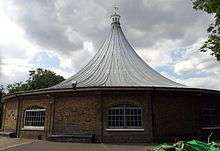 The Rotunda, Woolwich: home of the museum from 1820 to 2001 | |
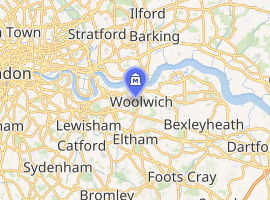
| |
| Established | 4 May 1820 |
|---|---|
| Dissolved | 8 July 2016 |
| Location | Woolwich |
History
The regiment initially consisted of two permanent companies of field artillery which were established in 1716, each 100 men strong; this became the "Royal Artillery" in 1720.[4] Originally based in the Royal Arsenal, beginning in 1770 the regiment was rehoused in the Royal Artillery Barracks on Woolwich Common.[5]
The Royal Military Repository

In 1778 Captain William Congreve set up a training establishment within the Warren, as an offshoot of the Royal Military Academy, to instruct officers in handling heavy equipment in the field of battle. His 'Repository of Military Machines' (soon given the title of Royal Military Repository ) was housed in a long two-storey building alongside the Carriage Works: cannons used for field training were stored on the ground floor while smaller items and models used for teaching purposes were displayed upstairs. Training initially took place on land to the east of the Warren and later moved to the woods to the west of Woolwich Common, close to the new Artillery Barracks, which are known still as 'Repository Grounds'. The Repository building itself was seriously damaged by fire (probably arson) in 1802. Those items that were saved or salvaged soon found a new home in the old premises of the Royal Military Academy, which itself moved from the Arsenal to Woolwich Common in 1806.[6]
The Museum in the Rotunda
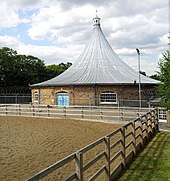
The Repository collection found a new home in a building of unusual provenance, secured for this purpose by the son of the Repository's founder (also named William Congreve). The Rotunda was initially erected in London in 1814 as an elaborate temporary marquee in the grounds of Carlton House. It was built for a ball given by the Prince Regent in honour of the Duke of Wellington in anticipation of victory over Napoleon Bonaparte; designed by John Nash, it was made to resemble a military bell tent.[7] After the victory celebrations were over the building languished without a use; but in 1818 the Prince Regent authorised the Rotunda's removal to Woolwich "to be appropriated to the conservation of the trophies obtained in the last war, the artillery models, and other military curiosities usually preserved in the Repository" and it was rebuilt on the eastern edge of the Repository Grounds.[8]
In its new accessible location the Repository became 'an early and free permanent public museum'.[8] Inside, trophies and weapons were arranged around the central column with display cases all around containing models and smaller exhibits;[9] larger artillery pieces were displayed outside.[10]
The museum continued in the Rotunda through to the very end of the 20th century, despite attempts at various times (including in 1932, 1953, in the 1960s and 1980s) to move it elsewhere. Eventually accommodation was secured for a new museum within what had been the Royal Arsenal, after the Army left the site in the 1990s. The Royal Artillery Museum in the Rotunda closed in 1999 (though the Rotunda continued to house the museum's reserve collection until 2010).[11]
Firepower
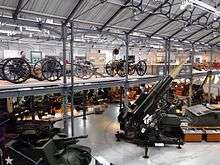
Between 2001[12] and 2016 the museum was branded as Firepower: The Royal Artillery Museum and housed in some of the former buildings of the Royal Arsenal. All Firepower's buildings were once part of the Royal Laboratory Department, which controlled the manufacture of ammunition; they are for the most part Grade II listed. The adjacent Greenwich Heritage Centre told the story of the local people of Greenwich who worked in the Arsenal and made the guns.[13]
Closure
Firepower closed in July 2016[14] and its buildings were acquired by Greenwich Council, which has hopes of establishing a "significant new cultural and heritage quarter" on the site.[15] The relocation of the museum was described by a board member as a "missed opportunity".[16][17] Greenwich Heritage Centre tried to fill the gap by creating a new permanent exhibition Making Woolwich: The Royal Regiment of Artillery in Woolwich. The project was supported amongst others by the Royal Regiment of Artillery, Royal Artillery Museums Ltd, Friends of the Royal Artillery Collections and the Royal Artillery Historical Trust.[18]
Future of the buildings
In 2017 it was announced that the Royal Borough of Greenwich has acquired five historic buildings around No 1 Street to create a £31 million cultural district. This includes buildings 17, 18 and 41, which were all used by Firepower. The plan includes a 450-seat black box theatre that will be built on the site of the former museum entrance. Building 17 (and other listed buildings nearby) will house rehearsal studios for resident companies such as Academy Performing Arts, Dash Arts, Chickenshed Theatre, Protein Dance, Greenwich Dance and Greenwich+Docklands International Festival. The Greenwich Heritage Centre was intended to move to the former James Clavell Library, until 2016 part of Firepower,[19][20] but closed in July 2018.[21]
Gallery of buildings
The following buildings were leased to Firepower by Greenwich London Borough Council:
.jpg) The main museum entrance opened into a new building, which housed the Modern Gunner galleries.
The main museum entrance opened into a new building, which housed the Modern Gunner galleries. To the right of the main entrance, the former Paper Cartridge Factory (Building 17, 1855-6) housed the main Gunnery Hall as well as the History Gallery and other exhibitions.[22]
To the right of the main entrance, the former Paper Cartridge Factory (Building 17, 1855-6) housed the main Gunnery Hall as well as the History Gallery and other exhibitions.[22] To the left of the main entrance, the former Royal Laboratory Offices (Building 18, 1855-6) housed museum offices and archives (James Clavell Library).
To the left of the main entrance, the former Royal Laboratory Offices (Building 18, 1855-6) housed museum offices and archives (James Clavell Library). Building 41 (opposite the main museum) was originally part of the New Laboratory Square factory complex; it housed large Cold War-era exhibits.
Building 41 (opposite the main museum) was originally part of the New Laboratory Square factory complex; it housed large Cold War-era exhibits.
Gallery of exhibits
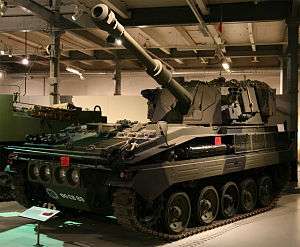
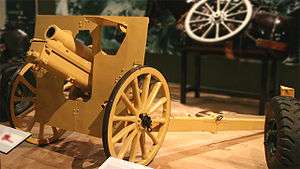 A 3.7 inch Mountain Howitzer
A 3.7 inch Mountain Howitzer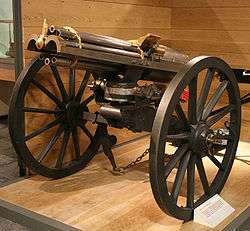
 A Section of the 1990-1991 Iraqi supergun
A Section of the 1990-1991 Iraqi supergun
Future plans
It was planned that the Royal Artillery Museum collection would be displayed in a new museum on Salisbury Plain, at Avon Camp West, south of Netheravon.[23] However, in 2020 the Chief of the General Staff withdrew his support for the lease of proposed site, leading to a "strategic re-appraisal" of the project.[24] In the meantime, the exhibits are being professionally stored and conserved in a museum stores nearby, but there is limited public access.[25]
References
- Michelin Green Guide: London. Michelin Travel & Lifestyle. 2012.
- "The Royal Artillery Museum". Retrieved 25 July 2020.
- "Designated Outstanding Collections" (PDF). Arts Council England. Retrieved 10 August 2016.
- History and Traditions of the Royal Artillery
- Saint, Andrew, Guillery, Peter (2012). Survey of London; Woolwich Volume 48 (PDF). Yale University Press. pp. 26–28. ISBN 978-0300187229.
- Binney, Marcus (21 March 2008). "Royal Military Academy in Woolwich is turned into luxury apartments". The Times. London. Retrieved 15 April 2011.
- "List entry for The Repository Grounds". Historic England. Retrieved 15 August 2016.
- "Survey of London, volume 48: Woolwich, chapter 7" (PDF). Bartlett School of Architecture. Yale Books. Retrieved 14 August 2016.
- "1828 illustration". British Museum. Retrieved 15 August 2016.
- "Large gun mounted outside the Royal Artillery Museum, Woolwich, South-east London". Alamy. Retrieved 26 July 2020.
- Stamp, Gavin (2013). Anti-Ugly: Excursions in English Architecture and Design. Aurum. p. 195. ISBN 978-1781311233.
- "Collections level description" (PDF). National Museum of Scotland. Retrieved 15 August 2016.
- "Welcome". Greenwich Heritage Centre. Retrieved 2 June 2018.
- "Press release" (PDF). Firepower museum. 8 July 2016. Archived from the original (PDF) on 10 September 2016.
- "Royal Borough of Greenwich launches London's newest cultural destination". Royal Borough of Greenwich. Retrieved 13 August 2016.
- "Woolwich Firepower Royal Artillery Museum 'to leave by 2017' – former board member hits out". Retrieved 26 May 2014.
- "A statement by the Chairman of the Royal Artillery Museum Board". Retrieved 8 July 2014.
- ‘Making Woolwich’ – A New Permanent Exhibition, 2016. greenwichheritage.org. Accessed: 22 February 2017
- "New creative district for London in the heart of Woolwich". Royalgreenwich.gov.uk. 29 March 2017. Retrieved 4 April 2017.
- Hill, Liz (30 March 2017). "Go-ahead for Woolwich creative district". Artsprofessional.co.uk. Retrieved 4 April 2017.
- "The Museum Collections & Archive is undergoing a period of redevelopment". Greenwich Heritage Centre. Retrieved 5 January 2019.
- Survey of London vol. 48: Woolwich. Yale. 2012.
- Griffin, Katy (13 March 2020). "Plans for new museum to preserve regiment's history". Salisbury Journal. Retrieved 25 July 2020.
- "Army Headquarters removes support for lease of land at Avon Camp West for the development of the Royal Artillery Museum". Figheldean Parish Council. 30 May 2020.
- "Firepower closure". Retrieved 16 August 2016.